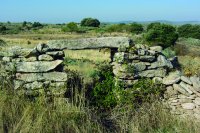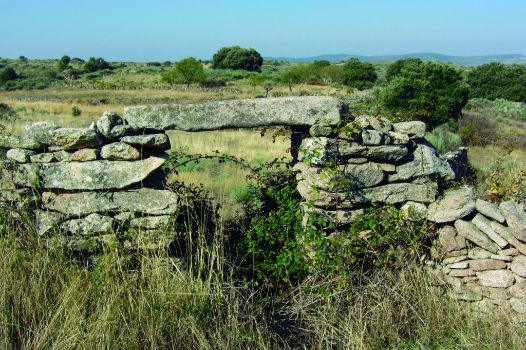Net of Natural
Trails

Stage 38: Mieza - Vilvestre
Description
Amidst grazing lands and orchards
The botanical environment at Mieza, where according to botanists there is one of the best hackberry and hornbeam forest in Western Europe, is the perfect setting for this Stage. A walk through this impressive landscape, dominated by rocks interspersed with plants, is a feast for the senses.
The Stage begins at Mieza. The path passes next to a watering trough and reaches a crossroads. It continues along the path on the left and rises towards Cerro de San Pedro. The landscape here consists of grazing lands, holm oaks (Quercus ilex) and slate walls that mark the property lines.

The road is easy and the horizon is broad. Orchards, especially cherry, almond and olive trees, alternate with grasslands that blanket the area around Charca de Las Escarbazas and Fuente de Milredondo. Dense oak stands dot the landscape, typically in the areas where a stack of stones has withstood the pressure of livestock.
A few kilometres further, the landscape opens up and one can sense the presence of Hondón del Duero, where the largest hackberry forest in Europe stands, sheltered from cold winds.
Weathered granite blocks compete with quartz outcrops in the area known as El Molmeral, offering charming views and a beautiful memory.
The route continues ahead through a wide, easy path. Yellow brooms (Cytisus scoparius) blanket the grasslands to the delight of cows, which use the branches to scratch their bellies. A large English poplar (Populus nigra) in the middle of a farm indicates the lowest point in this Stage. The route crosses the small Payitas Creek on a concrete bridge that runs parallel to a beautiful stone bridge, now in disuse.
The route is about to end, but first it must climb slightly up to Sierro de Caño. The Camino de Fermines leads the route to the town of Vilvestre. The village has wide streets and boasts the Shrine of Virgen del Castillo and a lichen-covered, stone cross. Once in the village, the road turns left and reaches a charming park where the Stage ends.
Sites of interest
Profile

Highlights
Further information
Hackberry
The few hackberry trees (Celtis australis) that grow here find one of the best shelters possible at Arribes del Duero.
The hackberry is a deciduous tree reaching twenty metres in height, although they typically do not exceed ten metres. It has a straight trunk and smooth bark that develops fissures with age.
Its leaves, which are shaped like a spearhead, are dark green on top and slightly lighter below. They are covered in white hairs and are smooth-textured.
The tree has been closely linked throughout history to many rural traditions and uses, including tools or livestock feed. The wood, hard and resistant, was also used to manufacture barrels. The fruit of the hackberry, which is sweet and rich in vitamin C, can be eaten raw or used to make jams and marmalades.



